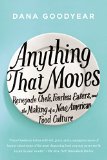Summary | Excerpt | Reviews | Beyond the Book | Readalikes | Genres & Themes | Author Bio
Renegade Chefs, Fearless Eaters, and the Making of a New American Food Culture

Critics' Opinion:
Readers' Opinion:
First Published:
Nov 2013, 272 pages
Paperback:
Nov 2014, 272 pages
 Book Reviewed by:
Book Reviewed by:
Poornima Apte
Buy This Book
In a couple of days, Hambleton said, he'd be leaving for Western China with Psihoyos,
and the six-person "Pirates of the Caribbean" prosthetics crew, who had designed him a new
face, with straight dark hair, a broadened nose, darkened skin, and brown contact lenses.
Disguised as a Chinese-American buyer, he was going to film at an exotic-meat market in
Wuhan, where tigers and dolphin heads are said to be sold openly, and use the footage for
a television show about environmental crime-solving. Psihoyos would probably have to sit
in a wheelchair to conceal his height. The prosthetics took six hours to apply, and had to
be worn overnight. He showed me a picture—shades of Mickey Rooney—and mentioned that he'd
also be looking for human-fetus soup. (Human-fetus soup is a hoax; the pictures online,
which Hambleton showed me on his laptop, are from a series called "Eating People" made by
a Chinese performance artist.)
Hambleton told me he had heard about The Hump from a source at Sea Shepherd, a renegade
anti-whaling organization. He wanted to sting them, and recruited Crystal to be the bait.
At an apartment in Santa Monica on the night of the operation, Hambleton removed a snap
from Crystal's Guess purse, and sewed a spy camera in its place. Crystal brought along a
Chinese friend who spoke fluent Japanese. They settled on a backstory: they'd just taken
jobs in Japan and wanted to acquaint themselves with the culture by eating the most exotic
food possible. "I thought, 'This will be scary and I don't know how I'll feel, but there's
no other option but to leave with a sample of whale meat,' " Crystal told me. Her friend,
Crystal said, wasn't vegan, nor was she an animal activist. She was in it for the free
sushi.
Not all that long ago, the U.S. government tried to convince people that whales, whose
oil was used to light lamps, lubricate transmissions, and make margarine, were edible.
In 1918, at a gathering at the American Museum of Natural History in New York described by
the New York Times as "a conservation luncheon," the chef from Delmonico's served
humpback pot au feu and whale planked a la Vancouver. The diners, "men prominent in
scientific, business, and professional spheres," praised it: so like venison! Given its
cheapness, they "were almost unanimously in favor of having whale meat substituted for
beefsteak and urged its immediate adoption as a feature of the national war diet." Again,
in 1943, the Times reported that "Whales, those greatest of mammals whose
pastures comprise seven seas, will be hunted for their flesh, which will be used to help fill
the gap in the nation's meat supply." The Department of the Interior gave reassurances
that the meat was "wholesome when properly handled and it does not have the fishy taste
which makes seal meat almost unpalatable."
Over the next several decades, the popular conception of whales began to shift, from
floating oil factories to noble, cerebral beings. In 1970, Roger Payne, a marine
scientist, published "Songs of the Humpback Whale," a recording of humpback music he and
his wife made from a sailboat: groaning whales, creaking rigging. Other researchers
reported advanced social behavior: humpbacks make bubble nets to trap their prey; sperms
can nurse for up to thirteen years; and killer-whale males live with their mothers into
adulthood. Much remained mysterious, particularly about the baleen whales, which are too
big to study in aquariums, but it was easy to make inferences from their large brains,
complex neural pathways, and the behavior of their clever smaller relatives, the dolphins.
The American public began to view killing them as both an ecological and an ethical
tragedy. After centuries of increasingly technological hunting, several whale species were
nearly extinct. Eating them, which in spite of the government's efforts, never caught on
here, suddenly struck people as obscene, practically cannibalistic. In 1972 Congress
passed the Marine Mammal Protection Act, prohibiting the taking and importation of whales,
dolphins, and porpoises, regardless of population numbers; the Endangered Species Act of
1973 outlawed the hunt, harassment, and capture of vulnerable populations. Violations of
these laws can lead to imprisonment and hundreds of thousands of dollars in fines. In addition, since 1986 the International Whaling Commission has upheld a worldwide moratorium on commercial whaling.
Excerpted from Anything That Moves by Dana Goodyear. Copyright © 2013 by Dana Goodyear. Excerpted by permission of Riverhead Books. All rights reserved. No part of this excerpt may be reproduced or reprinted without permission in writing from the publisher.





The Funeral Cryer by Wenyan Lu
Debut novelist Wenyan Lu brings us this witty yet profound story about one woman's midlife reawakening in contemporary rural China.
Your guide toexceptional books
BookBrowse seeks out and recommends the best in contemporary fiction and nonfiction—books that not only engage and entertain but also deepen our understanding of ourselves and the world around us.